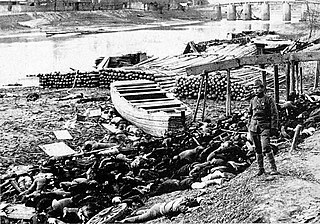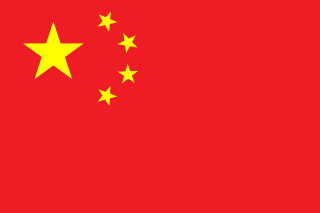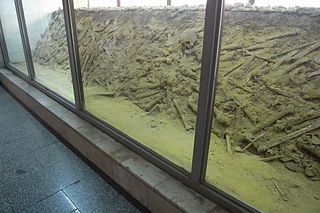Related Research Articles

The Nanjing Massacre or the Rape of Nanjing was the mass murder of Chinese civilians by the Imperial Japanese Army in Nanjing, the capital of the Republic of China, immediately after the Battle of Nanking and retreat of the National Revolutionary Army during the Second Sino-Japanese War. The massacre took place over a period of six weeks beginning on December 13, 1937. Estimates of the death toll vary from a low of 40,000 to a high of over 300,000, and estimates of rapes range from 20,000 to over 80,000. Most scholars support the validity of the International Military Tribunal for the Far East, which estimated that at least 200,000 were killed. Other crimes included torture, looting, and arson. The massacre is considered one of the worst wartime atrocities in history. In addition to civilians, numerous POWs and men who looked of military-age were indiscriminately murdered.

Unit 731, short for Manchu Detachment 731 and also known as the Kamo Detachment and the Ishii Unit, was a covert biological and chemical warfare research and development unit of the Imperial Japanese Army that engaged in lethal human experimentation and biological weapons manufacturing during the Second Sino-Japanese War (1937–1945) and World War II. Estimates vary as to how many were killed. Between 1936 and 1945, roughly 14,000 victims were murdered in Unit 731. It is estimated that at least 300,000 individuals have died due to infectious illnesses caused by the activities of Unit 731 and its affiliated research facilities. It was based in the Pingfang district of Harbin, the largest city in the Japanese puppet state of Manchukuo and had active branch offices throughout China and Southeast Asia.

Comfort women were women and girls forced into sexual slavery by the Imperial Japanese Armed Forces in occupied countries and territories before and during World War II. The term comfort women is a translation of the Japanese ianfu, a euphemism that literally means "comforting, consoling woman". During World War II, Japanese troops forced hundreds of thousands of women from Australia, Burma, China, the Netherlands, the Philippines, Japan, Korea, Indonesia, East Timor, New Guinea and other countries into sexual enslavement for Japanese troops; however, the majority of the women were from Korea. Many women died due to brutal mistreatment and sustained physical and emotional distress. After the war, Japan denied the existence of comfort women, refusing to provide an apology or appropriate restitution, which damaged Japan's reputation in Asia for decades. After numerous demands for an apology and the revelation of official records showing the Japanese government's culpability, the Japanese government began to offer an official apology and compensation in the 1990s. However, apologies from Japanese officials have been criticized as insincere, and Japanese government officials have continued to deny the existence of comfort women.

War reparations are compensation payments made after a war by one side to the other. They are intended to cover damage or injury inflicted during a war. War reparations can take the form of hard currency, precious metals, natural resources, industrial assets, or intellectual properties. Loss of territory in a peace settlement is usually considered to be distinct from war reparations.

Sook Ching was a mass killing that occurred from 18 February to 4 March 1942 in Singapore after it fell to the Japanese. It was a systematic purge and massacre of 'anti-Japanese' elements in Singapore, with the Singaporean Chinese particularly targeted by the Japanese military during the occupation. However, Japanese soldiers engaged in indiscriminate killing and did not try to identify who was 'anti-Japanese.'
Ong Iok-tek was a Taiwanese scholar and early leader of the Taiwan independence movement. He is considered to be an authority on the Southern Min language family and the Taiwanese language.

During its imperial era, the Empire of Japan committed numerous war crimes and crimes against humanity across various Asian-Pacific nations, notably during the Second Sino-Japanese and Pacific Wars. These incidents have been referred to as "the Asian Holocaust", and "Japan's Holocaust", and also as the "Rape of Asia". The crimes occurred during the early part of the Shōwa era, under Hirohito's reign.
The anti-Japanese demonstrations of 2005 were a series of demonstrations, some peaceful, some violent, which were held across most of East Asia in the spring of 2005. They were sparked off by a number of issues, including the approval of a Japanese history textbook and the proposal that Japan be granted a permanent seat on the United Nations Security Council.

Japan had an official slave system from the Yamato period until Toyotomi Hideyoshi abolished it in 1590. Afterwards, the Japanese government facilitated the use of "comfort women" as sex slaves from 1932 to 1945. Prisoners of war captured by Japanese imperial forces were also used as slaves during the same period.

The International Committee was established in 1937 to establish and manage the Nanking Safety Zone.

The Sino-Soviet conflict of 1929 was an armed conflict between the Soviet Union and the Chinese warlord Zhang Xueliang of the Republic of China over the Chinese Eastern Railway.

China–Japan relations or Sino-Japanese relations are the bilateral relations between China and Japan. The countries are geographically separated by the East China Sea. Japan has been strongly influenced throughout its history by China, especially by the East and Southeast through the gradual process of Sinicization with its language, architecture, culture, cuisine, religion, philosophy, and law. When Japan was forced to open trade relations with the West after the Perry Expedition in the mid-19th century, Japan plunged itself through an active process of Westernization during the Meiji Restoration in 1868 and began viewing China under the Qing dynasty as an antiquated civilization unable to defend itself against foreign forces—in part due to the First and Second Opium Wars along with the Eight-Nation Alliance's involvement in suppressing the Boxer Rebellion. Japan eventually took advantage of such weaknesses by invading China, including the First Sino-Japanese War and the Second Sino-Japanese War.

A Taiwanese Imperial Japan Serviceman is any Taiwanese person who served in the Imperial Japanese Army or Navy during World War II whether as a soldier, a sailor, or in another non-combat capacity. According to statistics provided by Japan's Ministry of Health, Labour and Welfare, during the Second Sino-Japanese War and the subsequent World War II, a total of 207,183 Taiwanese served in the military of Imperial Japan and 30,304 of them were declared killed or missing in action. The vast majority of Taiwanese servicemen up to 1944 were in non-combatant roles and the majority of Taiwanese combatants were deployed in Southeast Asia as Japan did not trust them to fight against mainland Chinese. Taiwanese servicemen were abandoned by Japan at the end of the war and no transportation for their return was provided. Ex-servicemen failed to obtain restitution for unpaid wages from Japan in the following decades.
Nanjing Massacre denial is the pseudohistorical claim denying that Imperial Japanese forces murdered and raped hundreds of thousands of Chinese soldiers and civilians in the city of Nanjing during the Second Sino-Japanese War. This is relevant today in Sino-Japanese relations. Most historians accept the findings of the Tokyo tribunal with respect to the scope and nature of the atrocities which were committed by the Imperial Japanese Army after the Battle of Nanjing. In Japan, however, there has been a debate over the extent and nature of the massacre with some historians attempting to downplay or outright deny that the massacre took place.

The national flag of the People's Republic of China, also known as the Five-star Red Flag, is a Chinese red field with five golden stars charged at the canton. The design features one large star, with four smaller stars in an arc set off towards the fly. It has been the national flag of China since the foundation of the People's Republic of China on 1 October 1949. The flag was designed by Zeng Liansong.

The total death toll of the Nanjing Massacre is a highly contentious subject in Chinese and Japanese historiography. Following the outbreak of the Second Sino-Japanese War, the Japanese Imperial Army marched from Shanghai to the Chinese capital city of Nanjing (Nanking), and though a large number of Chinese POWs and civilians were slaughtered by the Japanese following their entrance into Nanjing on December 13, 1937, the precise number remains unknown. Since the late-1960s when the first academic works on the Nanjing Massacre were produced, estimating the approximate death toll of the massacre has been a major topic of scholarly debate.
Kwong Tong Cemetery is the largest and oldest cemetery located in Bukit Petaling, Kuala Lumpur, Malaysia. It covers an approximate area of 333 acres of land and is the final resting place of many notable pioneers in Malaysia. In 2007, the 112-year-old cemetery was named a Heritage Park.
Yang You is a Chinese scientist and former president of Sanda University between 1992 and 1997. Yang is the teacher of Huang Xuhua, Xu Qinan, Zhu Yingfu, and Zeng Hengyi.

Tong Zeng is a Chinese scholar, peace activist, and businessman. He is chairman of the China Federation of Demanding Compensation from Japan, and is chairman of Zhongxiang Investment Co., Ltd.
References
- ↑ "10000 Cries for Justice — Letters to Tong Zeng". 10000cfj.org. 2015.
- ↑ Zeng, Tong (April 1, 2020). "LETTERS TO TONG ZENG". Amazon .
- ↑ "45 Years of Normalized Sino-Japanese Diplomacy Reflections on bilateral relations and an outlook for the future". The Diplomat . September 11, 2017.
- ↑ Zeng, Tong (March 25, 1991). "It Is of Great Urgency that China Demand Damage Compensation from Japan" (PDF). vjday.org.
- ↑ "Campaign of Civil Claims for Compensation from Japan" (PDF). Overseas Chinese Daily News(Hong Kong). July 19, 1992.
- ↑ Shen, Li (February 6, 2005). "Chinese Campaigners Inspired by Korean Project (Create Tong Zeng salon website www:tzsl.org )". China Internet Information Center Source: China Youth Daily .
- ↑ Jianmian, Wu (February 7, 1993). "On June 13, 1941, the Japanese captured 63 people in the whole village(This letter has not been translated into English)". 10000cfj.
- ↑ Lei, Zhang (October 11, 2017). "An unfulfilled wish of a Japanese journalist in China". China Youth Daily .
- ↑ "China-US website highlights Japanese war crimes.Source: Xinhua News Agency". Equipo Nizkor(Equipo Nizkor es una organizacion internacional de defensa de las libertades civiles y para la aplicación del derecho internacional). July 22, 2015.
- ↑ "China-U.S. website highlights Japanese war crimes". ECNS . July 23, 2015.
- ↑ "10,000 Cries for Justice (13th International Conference on Interdisciplinary Social Sciences University of Granada, Granada, Spain)". Slideplayer (Slides are rich in content). July 25, 2018.
- ↑ "Civil claims for post-war compensation aims at peace and friendship". People's Daily Online People's Daily . January 23, 2018.
- ↑ Lan, Yao (July 7, 2017). "Letters to Tong Zeng -- a treasure house of historical materials for the victims of Japan's war of aggression against China". China Youth Daily (Chinese report).
- ↑ "Book of WWII victims' letters to be published". ECNS . January 15, 2018.
- ↑ Lei, Zhang (March 13, 2018). "Proposal by members of the National Committee of the Chinese People's Political Consultative Conference: It is proposed to apply for "Letters to Tong Zeng " as a "Memory of the World Heritage" in 2018". China Youth Daily (chinese).